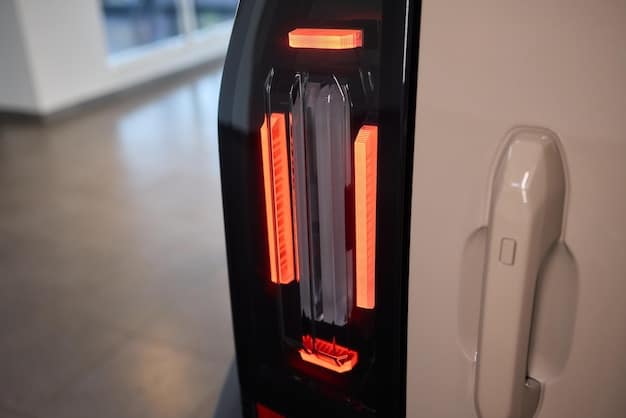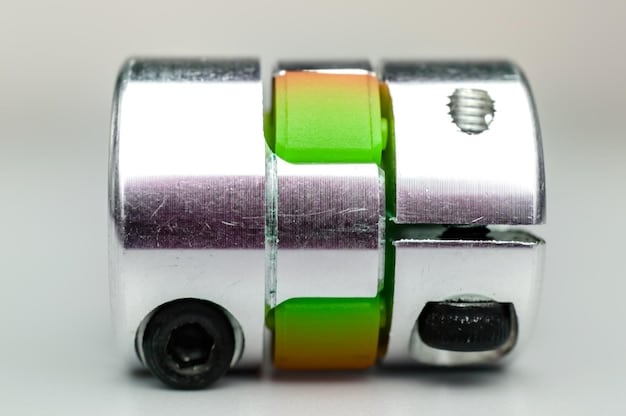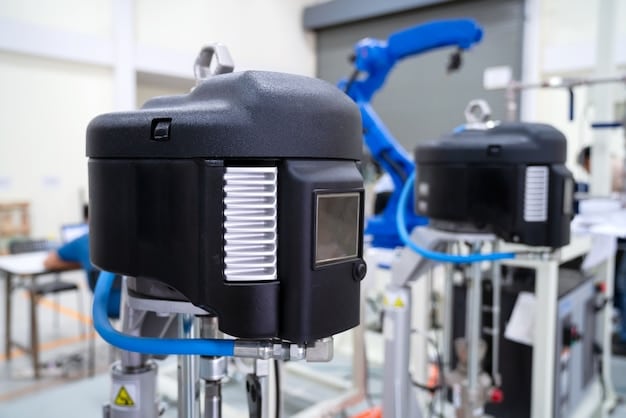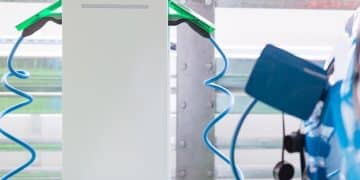The Future of Car Batteries: Will Solid-State Replace Lithium-Ion by 2030?

The future of car batteries is rapidly evolving, with solid-state batteries emerging as a potential successor to lithium-ion technology by 2030, promising enhanced safety, higher energy density, and faster charging capabilities that could revolutionize the electric vehicle industry.
The electric vehicle (EV) market is booming, and at the heart of this revolution lies the car battery. For years, lithium-ion batteries have been the reigning champion, powering everything from smartphones to Teslas. But a new contender is entering the arena: solid-state batteries. The question on everyone’s mind is: Will the future of car batteries: Will solid-state batteries replace lithium-ion by 2030?
Understanding the Lithium-Ion Battery Landscape
Lithium-ion batteries have become ubiquitous, powering our mobile phones, laptops, and electric vehicles. They offer a compelling combination of energy density, power, and lifespan compared to older battery technologies. However, they also have their limitations, particularly when it comes to safety and energy density for automotive applications.
The Strengths of Lithium-Ion Batteries
Lithium-ion batteries have several characteristics that have made them the dominant force in the EV market.
- High energy density, allowing for decent driving ranges.
- Relatively long lifespan, with many batteries lasting for hundreds of thousands of miles.
- Well-established manufacturing processes, making them cost-effective to produce at scale.
The Drawbacks of Lithium-Ion Batteries
Despite their many advantages, lithium-ion batteries do have some significant drawbacks.
- Safety concerns due to the flammable liquid electrolyte, which can lead to thermal runaway and fires.
- Lower energy density compared to theoretical limits, restricting driving range.
- Degradation over time, reducing battery capacity and performance.
Lithium-ion batteries have served us well, but the need for safer, more powerful, and longer-lasting batteries is driving the search for alternatives. This is where solid-state batteries come into the picture.
The Promise of Solid-State Batteries
Solid-state batteries represent a significant departure from traditional lithium-ion technology. Instead of using a liquid electrolyte, they employ a solid electrolyte, which offers a range of potential benefits.

Enhanced Safety
One of the most compelling advantages of solid-state batteries is their improved safety. The solid electrolyte is non-flammable, eliminating the risk of thermal runaway and fires that can occur with liquid electrolytes.
Higher Energy Density
Solid-state batteries have the potential to significantly increase energy density. This means that EVs could travel much farther on a single charge, addressing one of the major concerns of prospective EV buyers.
Faster Charging Times
The solid electrolyte in these batteries may allow for faster charging times. This could drastically reduce the amount of time spent waiting at charging stations, making EVs even more convenient.
Solid-state batteries offer a solution to the shortcomings of lithium-ion batteries, promising a new era of safer, more efficient, and more convenient EVs.
Current State of Solid-State Battery Technology
While the potential of solid-state batteries is immense, the technology is still in its early stages of development. Several companies and research institutions are actively working on bringing solid-state batteries to market, but significant challenges remain.
Key Players in Solid-State Battery Development
Many companies are investing heavily in solid-state battery research and development. Some of the key players include:
- Toyota
- QuantumScape
- Solid Power
Challenges in Production
Despite the progress, several hurdles need to be overcome before solid-state batteries can be mass-produced. Some of these challenges include:
- Manufacturing scalability: Developing cost-effective manufacturing processes is critical.
- Material science: Finding the right solid electrolyte material with high ionic conductivity and stability.
- Cost: Reducing the cost of solid-state batteries to make them competitive with lithium-ion batteries.

Overcoming these challenges will be crucial for the widespread adoption of solid-state batteries in EVs.
Potential Impact on the EV Market
If solid-state batteries live up to their promise, they could have a profound impact on the EV market. Enhanced safety, longer range, and faster charging times could attract a wider range of consumers, accelerating the transition to electric vehicles.
Increased EV Adoption Rates
The improved performance characteristics of solid-state batteries could address some of the key concerns that prevent consumers from switching to EVs.
- Range anxiety: Longer driving ranges would alleviate the fear of running out of charge.
- Charging convenience: Faster charging times would make EVs more practical for everyday use.
- Safety concerns: Enhanced safety would reassure consumers worried about battery fires.
Changes in Battery Manufacturing and Supply Chains
The shift to solid-state batteries could also lead to significant changes in battery manufacturing and supply chains.
- New materials: Solid-state batteries may require different raw materials, impacting the demand for certain minerals.
- New manufacturing processes: Existing battery factories may need to be retooled to produce solid-state batteries.
- Geopolitical implications: The shift in battery technology could alter the balance of power in the global battery market.
Solid-state batteries have the potential to fundamentally reshape the EV landscape, driving innovation, accelerating adoption, and transforming the automotive industry.
The 2030 Timeline: Realistic or Optimistic?
The question of whether solid-state batteries will replace lithium-ion batteries by 2030 is a complex one. While the technology is advancing rapidly, several factors could influence the timeline.
Optimistic Scenarios
In an optimistic scenario, solid-state batteries could be in widespread use by 2030. This would require:
- Breakthroughs in material science to improve battery performance and reduce costs.
- Rapid scaling of manufacturing capacity to meet growing demand.
- Strong government support and investment in solid-state battery technology.
Pessimistic Scenarios
In a more pessimistic scenario, solid-state batteries may not be ready for widespread adoption by 2030. This could happen if:
- Technological challenges prove more difficult to overcome than anticipated.
- Manufacturing challenges delay the scaling of production.
- Lithium-ion batteries continue to improve, narrowing the performance gap.
The actual timeline will likely fall somewhere in between these two extremes. It is possible that solid-state batteries will be used in niche applications or high-end EVs by 2030, with broader adoption occurring in the following years.
Preparing for the Future of Car Batteries
Whether solid-state batteries become the dominant technology by 2030 or not, it is clear that the future of car batteries is changing. Businesses and consumers alike need to prepare for these changes.
Strategies for Automakers
Automakers should:
- Invest in solid-state battery research and development to stay ahead of the curve.
- Diversify their battery supply chains to reduce reliance on lithium-ion batteries.
- Develop flexible manufacturing platforms that can accommodate both lithium-ion and solid-state batteries.
Implications for Consumers
Consumers should:
- Stay informed about the latest battery technology developments.
- Consider the long-term cost and performance of different battery types when purchasing an EV.
- Be prepared for changes in charging infrastructure and battery recycling programs.
The transition to new battery technologies will require collaboration, innovation, and careful planning to ensure a smooth and successful transition.
| Key Point | Brief Description |
|---|---|
| ⚡ Safety | Solid-state batteries enhance safety due to their non-flammable solid electrolyte. |
| 🔋 Energy Density | Potential for higher energy density, leading to extended driving ranges. |
| ⏱️ Charging Time | Faster charging times could reduce waiting at charging stations. |
| 🏭 Production | Challenges exist in scaling up production and reducing costs. |
FAQ
▼
Solid-state batteries use solid electrolytes instead of the liquid or polymer gel electrolytes found in lithium-ion batteries, offering potential benefits in safety, energy density, and lifespan.
▼
Solid-state batteries enhance safety by using non-flammable solid electrolytes, thus eliminating the risk of thermal runaway and fires associated with the liquid electrolytes in lithium-ion batteries.
▼
Several companies are actively working on solid-state battery technology, including Toyota, QuantumScape, and Solid Power. These companies aim to bring solid-state batteries to mass production.
▼
The main challenges include achieving scalable manufacturing, identifying suitable solid electrolyte materials with high conductivity, and reducing the overall cost to compete effectively with lithium-ion batteries.
▼
The prospect of longer driving ranges, faster charging times, and increased safety could encourage more consumers to transition to EVs, thus accelerating the overall adoption of electric vehicles.
Conclusion
The future of car batteries: Will solid-state batteries replace lithium-ion by 2030? remains to be seen, but the potential benefits are undeniable. While challenges remain, the progress being made in solid-state battery technology suggests that it could play a significant role in the future of electric vehicles, potentially leading to safer, more efficient, and more convenient transportation.





